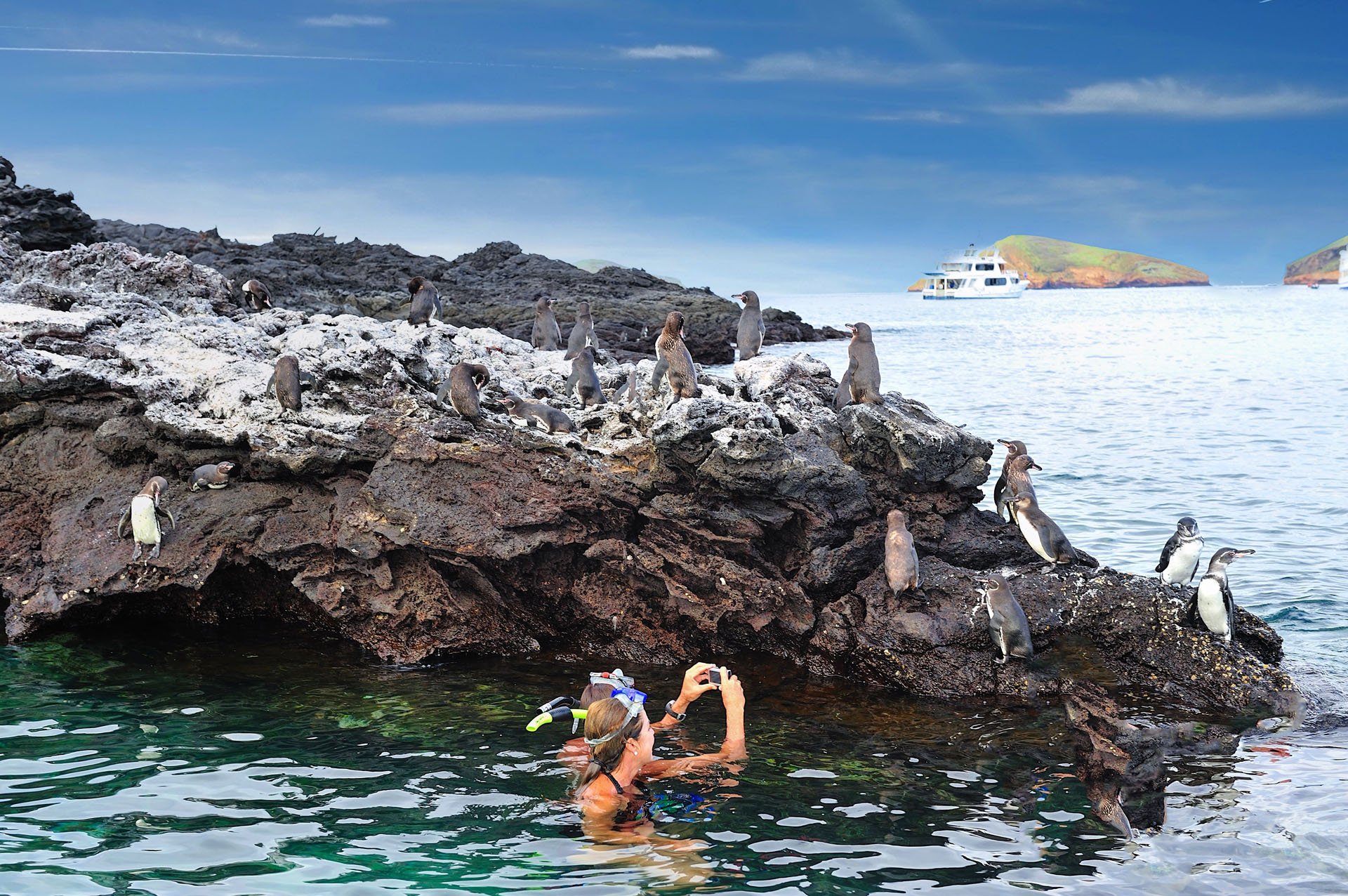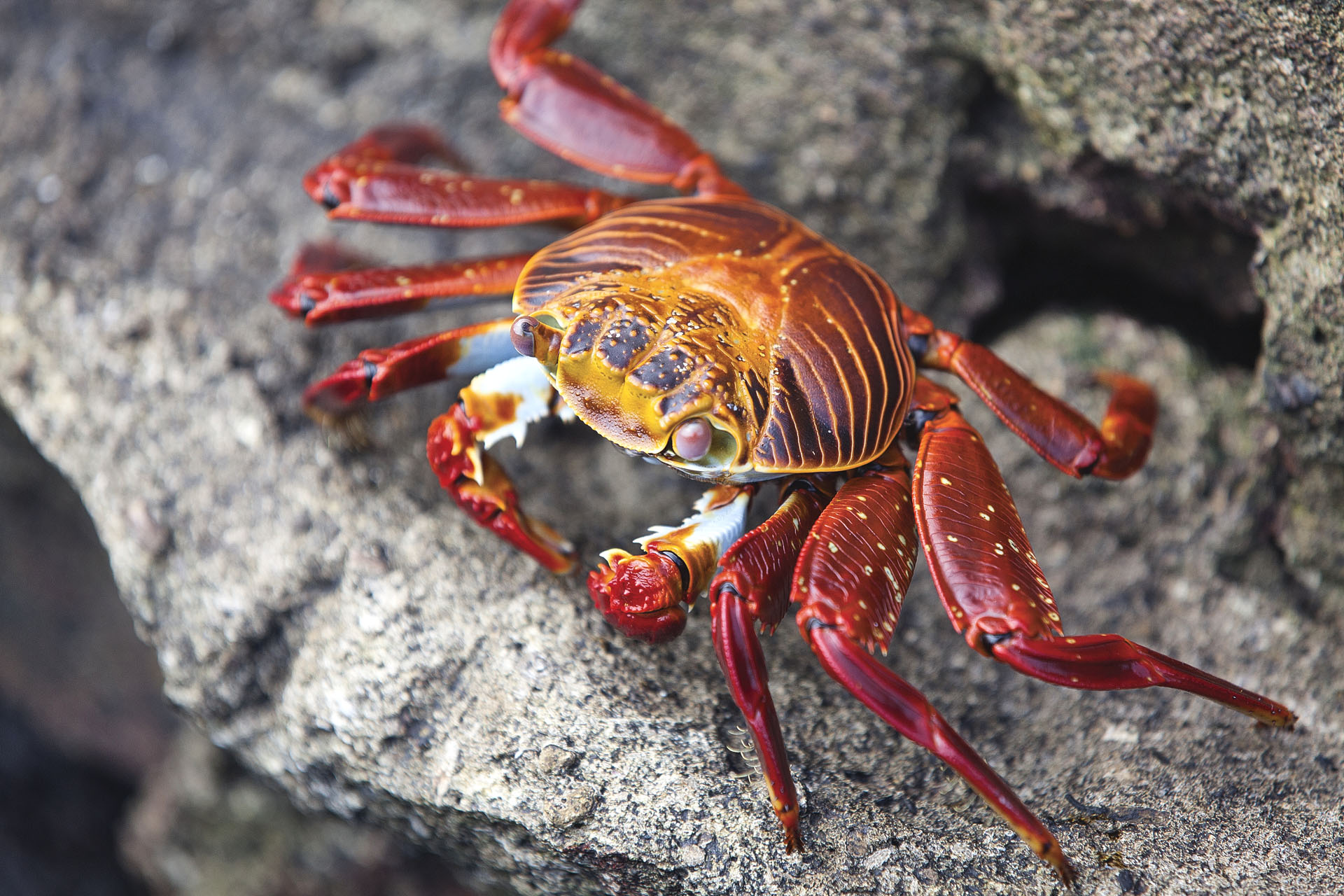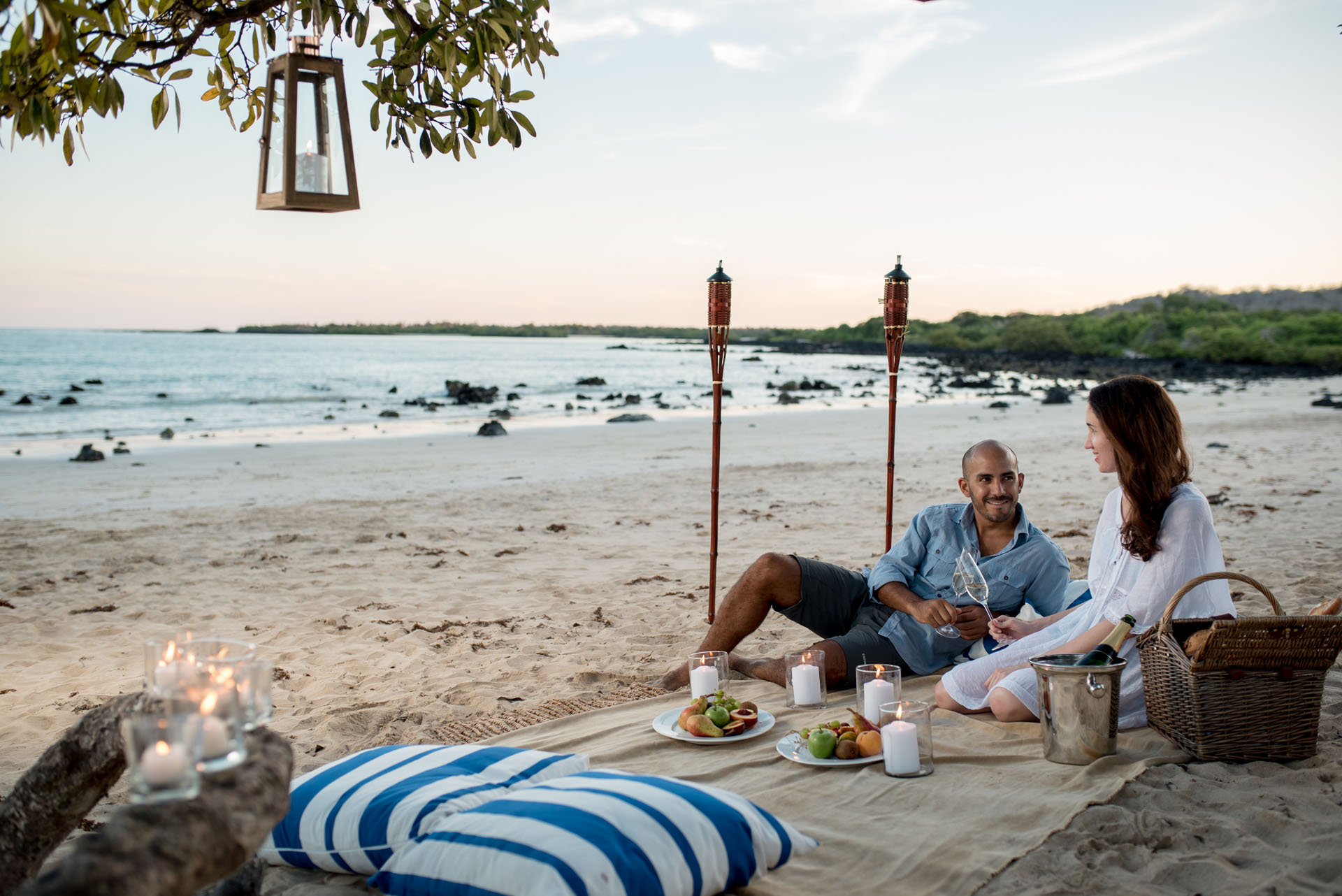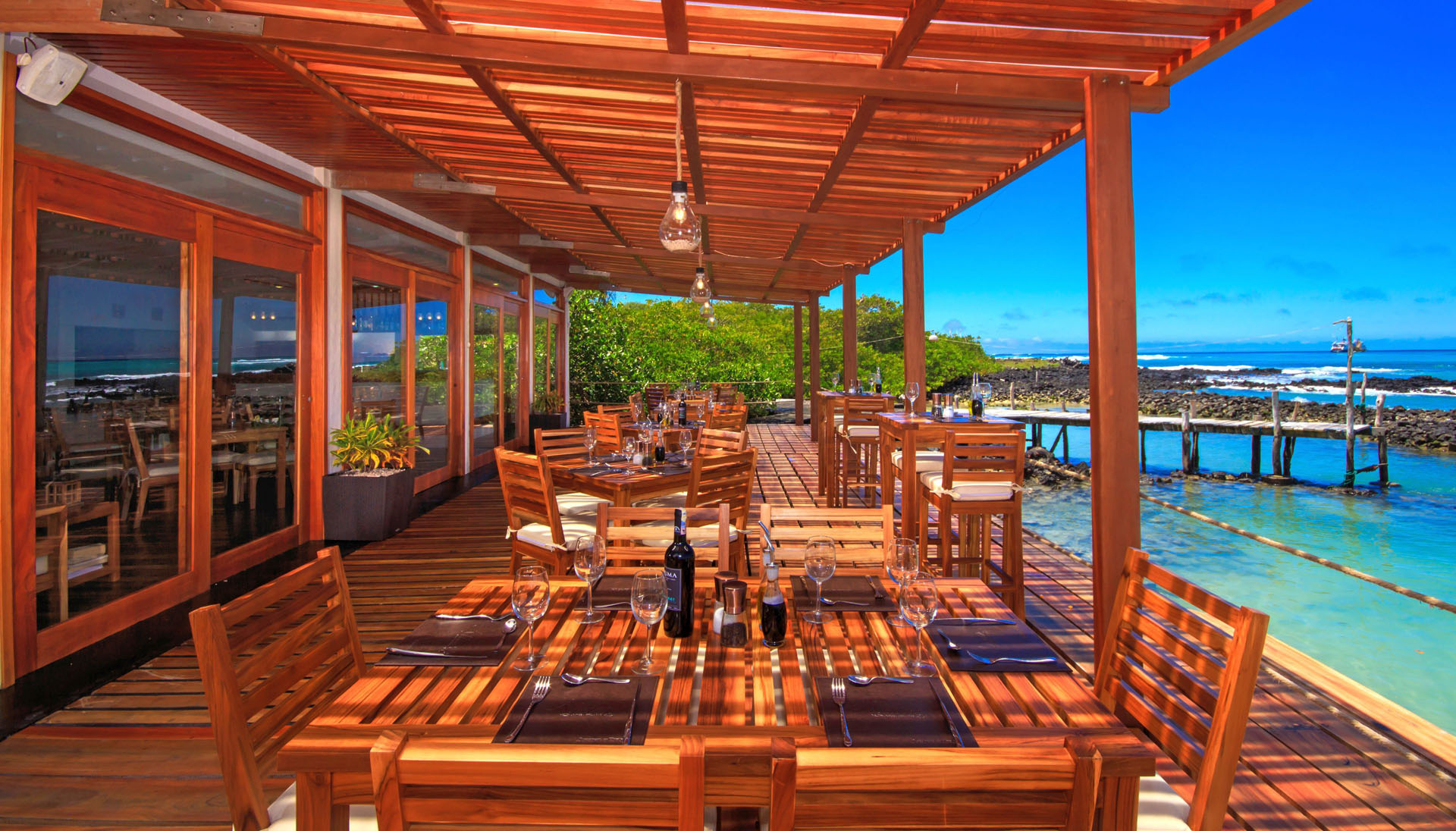WITH AN ALMOST MYTHICAL SHOWCASE OF BIODIVERSITY A LAND WITH MORE UNIQUE SPECIES THAN ANYWHERE ELSE ON THE MAP THE FARAWAY GALÁPAGOS ISLANDS TAKE INTREPID TRAVELERS ON A GRIPPING JOURNEY THROUGH TIME AND NATURE
BY AMANDA McCOY
Avolcanic archipelago hidden deep in the Pacific Ocean, the Galápagos Islands are one of the world’s most fascinating destinations, heralded as a living museum rich in biodiversity. The islands’ remote, isolated location (roughly 600 miles west of the coast of Ecuador) and unique position between two cold ocean currents on the equator lend a wildly diverse portfolio of flora and fauna, including 9,000 species of animal, many of which can’t be found anywhere else in the world. Though officially discovered by the bishop of Panama in 1535, the 19-island archipelago’s inhospitable terrain prevented permanent habitation, and the Galápagos remained mostly a secret until an intrepid young naturalist named Charles Darwin introduced the islands along with the theory of evolution to the rest of the world. Visitors are treated to a fascinating mosaic of native wildlife, including marine iguanas, giant tortoises, waved albatrosses, Sally Lightfoot crabs, flamingos, blue-footed boobies, frigate birds, sea lions, and Darwin’s famed finches. Thanks to the cold, nutrient-rich waters of the Humboldt Current, a low salinity ocean current that flows north from Antarctica along the west coast of South America, penguins also take up residence on the islands year round. The small, slender Galápagos penguin is the most northerly species of penguin in the world and primarily dwells on the islands of Isabela and Fernandina. Visitors often see them swim around Pinnacle Rock, a 600-foot-tall volcanic plug along the coast of Bartolomé Island. Unfortunately, due to a rising number of threats that include habitat degradation, overfishing, and a shifting climate, the Galápagos penguins and many other species of native fauna are considered endangered, but there are myriad conservation efforts underway to re-wild the archipelago and protect its enchanting wildlife.

KNOW BEFORE YOU GO
There are two airports on the Galápagos, with daily direct flights from the Ecuadorian cities of Guayaquil and Quito. Note that upon arrival in the Galápagos, non-Ecuadorian adults will need to pay an entrance fee of $100 in cash to the Galápagos National Park ($50 for children). The islands’ equatorial location affords lush, tropical climates year round. November is the last month of the cooler garua season, which usually yields more aquatic life sightings, such as dolphins, whales, fur seals, rays, and sea turtles. Though December marks the start of the rainy season, showers are typically brief and intermittent.
While there are a growing number of hotels and resorts on the mainland, the most popular way to explore this feral wonderland is via boat. Several luxury operators offer cruises from three to 11 nights, and most depart from Baltra Island. Itineraries range from $4,500 to $19,000, and tend to fill up quickly, so we recommend booking at least six months in advance.
ATTRACTIONS
TORTUGA BAY
A 20-minute water-taxi ride or scenic 1.5-hour hike from Puerto Ayora will lead you to this dreamy visitor site on the south side of Santa Cruz, boasting a long white coral sand beach and turquoise waters. Unlike many of the islands’ top tourist attractions, you don’t need a guide to visit, but you will need to sign in and out upon arrival/departure. Here, a plethora of activities awaits: bird watch, sunbathe, swim in the nearby coves, snorkel, or walk through the dense vegetation to discover a spread of wildlife, including the famed blue-footed boobies, a marine bird with vibrant sky blue feet. In the water, find sea lions, white tip reef sharks, tiger sharks, manta rays, ghost crabs, and giant sea turtles, plus hundreds of species of tropical fish.

PUERTO VILLAMIL
This charming fishing village on the island of Isabela (the largest in the archipelago) is much smaller and more rural than Puerto Ayora in Santa Cruz, but that yields supreme wildlife sightings. The coastal hamlet is famed for its long, sugar-sand, palm-lined beaches and lagoons filled with flamingos, common stilts, whimbrels, white-cheeked pintails, and more, plus several giant tortoises. Rent bikes and explore the town, home to several bars and restaurants, and nearby sights, such as lava caves, wetlands, and the Wall of Tears, one of the island’s most historically significant sites. There’s also exceptional snorkeling in the waters of the Las Tintoreras islet and Concha de Perla, famous for sea lions, turtles, and penguins.

WHERE TO STAY
PIKAIA LODGE
Rising from an extinct volcanic crater top, this remote eco-resort in Santa Cruz is a stunning example of sustainable luxury. Featuring minimalist, glass-sided guestrooms and suites that overlook the feral surrounds, the boutique lodge puts its guests up close and personal with the natural wonder of the Galápagos’ central most island. Pikaia is an excellent alternative to multi-day yacht cruises for visitors who would rather slumber on solid ground at night, but the resort still offers robust land and yacht-based programs to explore nearby islands, colorful marine reserves, secluded white sand beaches, and more. Embark on a bird-watching expedition or dive through the wild life rich waters before returning to the luxury lodge for a quick dip in the infinity pool and candlelit dinner at Evolution Restaurant. The resort is located on a private giant tortoise reserve, so be prepared to meet century-old friends as you roam the grounds. A three-night stay in a Terrace Room begins at $4,305. Sector El Camote a 100 m del Cerro Mesa, Santa Cruz, pikaialodge.com

SILVERSEA SILVER ORIGIN
Sailing the bountiful waters that connect the 19 islands of the archipelago remains the top visitor excursion in the Galápagos, and many travelers opt to keep the adventure going and sleep atop the rolling sea. Explore one of the world’s most biologically diverse destinations aboard a sweeping variety of vessels, from private yacht charters, sailboats, and tiny-group catamarans to all-suite mega-yachts. Italian luxury cruise liner Silver sea operates the Silver Origin, its first destination-specific ship designed for voyaging the Galápagos. The 51-suite ship offers some of the largest and most elegant accommodations on the islands, each featuring 24-hour butler service. Spring for the Owner’s Suite, a nearly 1,800-squarefoot palace with a private veranda, dedicated sitting area, and modern en-suite with a whirlpool bath that overlooks the ocean. There are two restaurants on board, plus a beauty salon, fitness center, full-service spa, observation lounge, and open-air explorer lounge, perfect for peeping sea lions, green turtles, and whales. silversea.com

WHERE TO DINE/DRINK
FINCH BAY RESTAURANT
Located within the beachfront Finch Bay Hotel in Santa Cruz, this gourmet eatery is considered among the top-rated epicurean experiences in the Galápagos, serving stunningly presented ocean and island fare amid the gentle whisper of the sea. An on-site herb garden (playfully named Chakrita) provides all the accoutrements for native dishes like island locro, a traditional potato soup with farmer’s cheese; bacon and corn spaghetti with fresh parsley cream reduction; and duck a l’orange, featuring crisp local duck smothered in bitter orange sauce and accompanied by mashed local potatoes with caramelized onions and orange peel. There’s also a variety of Ecuadorian ceviches, and true a cionados can try their dicing hand in an on-site ceviche-making class. Barrio Punta Estrada, Puerto Ayora, nchbayhotel.com/restaurant

ALMAR SEAFOOD AND GRILL
Modern Ecuadorian, Argentine, and Galápagos flavors collide at this swanky seaside favorite on the island of Santa Cruz, featuring a colorful menu crafted of farm and ocean-to-fork meats, seafood, and produce. The owners work with local purveyors and farmers to ensure the fish is crisp, the meat is tender, and the vegetables are vivid and teeming with flavor. While there are vegan and meat dishes on deck, seafood reigns supreme here, with standouts including octopus, cod fish, shrimp, and tuna, each delicately dressed with local fruits or homemade sauces. Be on the lookout for animal visitors, as the waterfront location usually yields sea lion, iguana, and even sea turtle sightings. The coffee here also has a cult following. Ave Charles Darwin, Puerto Ayora, almargalapagos.com

LOS KIOSKOS
Amid the sea of chic, ocean-forward eateries peppered throughout the islands, there’s a rising street food scene that spoils tourists with the authentic flavors of Galápagos classics. Los Kioskos, located in the central town of Puerto Ayora, is a vibrant thoroughfare lined with stalls hawking freshly grilled barbecue, witch fish, and Galápagos lobster, plus coconuts, stews, and churo (sea snails). Each dish is cooked with guava wood, lending a tropical smokiness to the meats and fish. Be sure to try the arroz con menestra (a Guayaquil staple), a lentil stew slow simmered with onion, pepper, tomato, garlic, cumin, and loads of cilantro, or an encocao, a popular fish dish smothered in coconut sauce.


